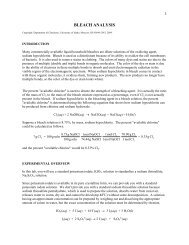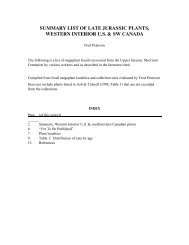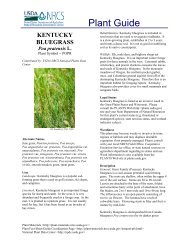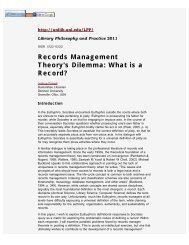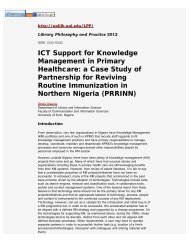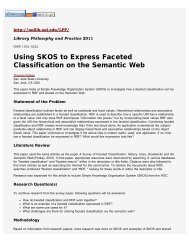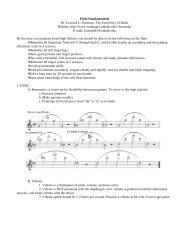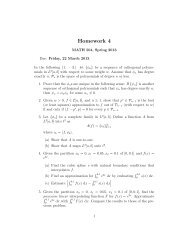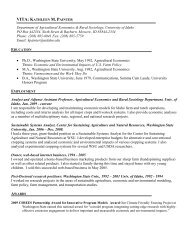Value-added Utilization of Crude Glycerol from Biodiesel Production ...
Value-added Utilization of Crude Glycerol from Biodiesel Production ...
Value-added Utilization of Crude Glycerol from Biodiesel Production ...
Create successful ePaper yourself
Turn your PDF publications into a flip-book with our unique Google optimized e-Paper software.
eforming <strong>of</strong> glycerol in the gas phase with catalysts loaded with Group 8-10 metals. The catalysts were<br />
prepared via a conventional impregnation method, using Y2O3, ZrO2, CeO2, LaO3, SiO2, MgO, and Al2O3<br />
as supports. A fixed-bed, flow-type reactor made <strong>of</strong> stainless steel was operated at atmospheric pressure.<br />
An aqueous solution <strong>of</strong> glycerin was fed by a micropump for high-performance liquid chromatography.<br />
Alumina balls were placed above a catalyst bed to preheat the glycerine mixture using fixed amount <strong>of</strong><br />
catalyst for each run. According to them loading <strong>of</strong> 3 %wt ruthenium on Y2O3 at 500°C is optimal for the<br />
steam reforming <strong>of</strong> glycerin gave the best results. The following is the chemistry <strong>of</strong> the reactions.<br />
Huber et al. (2003) did aqueous-phase reforming <strong>of</strong> biomass-derived oxygenated hydrocarbons over a<br />
tin-promoted Raney-nickel catalyst. The temperatures were around 500 K. The desired catalytic pathway<br />
for the production <strong>of</strong> H2 and CO2 by aqueous-phase reforming <strong>of</strong> oxygenated hydrocarbons involves<br />
cleavage <strong>of</strong> C-C bonds as well as C-H and/or O-H bonds to form adsorbed species on the catalyst<br />
surface. Cleavage <strong>of</strong> these bonds occurs readily over group-8 metals, such as Pd and Rh. The<br />
performance was comparable with relatively costly platinum-based catalysts for production <strong>of</strong> hydrogen<br />
<strong>from</strong> ethylene glycol, glycerol, and sorbitol. The optimal Sn-promoted Raney-Ni catalyst was prepared by<br />
decomposition <strong>of</strong> tributyl tin acetate and had a bulk Sn/Ni atomic ratio <strong>of</strong> 0.075. They found a decrease <strong>of</strong><br />
methanol formation with addition <strong>of</strong> tin to nickel. Another process reported for hydrogen production is the<br />
pyrolysis and steam gasification <strong>of</strong> glycerol. Valliyappan (2004) carried out reactions in an inconel,<br />
tubular, fixed bed down-flow reactor at atmospheric pressure. He studied the effects <strong>of</strong> carrier gas flow<br />
rate, temperature and different particle diameter <strong>of</strong> different packing material on the product yield, product<br />
gas volume, composition and calorific value. According to him increase in carrier gas flow rate showed<br />
insignificant effect on synthesis gas production at 800ºC with quartz chips diameter <strong>of</strong> 3-4 mm. This<br />
increased gas yield <strong>from</strong> 65 to 72 %wt while liquid yield decreased <strong>from</strong> 30.7 to 19.3 %wt when carrier<br />
gas flow rate decreased <strong>from</strong> 70 to 30 mL/min. Reaction temperature showed linear response for the<br />
hydrogen yield increasing <strong>from</strong> 17 to 48.6 mol% and synthesis gas production increasing <strong>from</strong> 70 to 93<br />
mol%. Pyrolysis reaction at 800°C, 50 /min <strong>of</strong> nitrogen and quartz particle diameter <strong>of</strong> 0.21-0.35 mm<br />
maximized the gas product yield (71 %wt), hydrogen yield (55.4 %mol), synthesis gas yield (93 %mol)<br />
and volume <strong>of</strong> product gas (1.32 L/g <strong>of</strong> glycerol). The steam gasification <strong>of</strong> glycerol was carried with two<br />
different packing materials quartz and silicon carbide by changing the steam to glycerol weight ratio <strong>from</strong><br />
0:100 to 50:50. The addition <strong>of</strong> steam to glycerol increased the hydrogen yield <strong>from</strong> 55.4 to 64 mol% and<br />
volume <strong>of</strong> the product gas <strong>from</strong> 1.32 L/g for pyrolysis to 1.71 L/g <strong>of</strong> glycerol. Synthesis gas yield and<br />
calorific value <strong>of</strong> the product gas at this condition was 92 mol% and 13.5MJ/m 3 , respectively. The net<br />
energy recovered at this condition was 117.19 kJ/mol <strong>of</strong> glycerol fed.<br />
Polyglycerols<br />
Polyglycerol esters find their utilization as antifogging and antistatic additives, lubricants, or plasticizers.<br />
Clacens et al. (2002) studied the selective etherification <strong>of</strong> glycerol. Etherification was carried out at 533 K<br />
in a batch reactor at atmospheric pressure under N2 in the presence <strong>of</strong> 2 %wt <strong>of</strong> catalyst, water being<br />
eliminated and collected using a Dean-Stark system. They studied impregnation <strong>of</strong> mesoporous solids<br />
with different basic elements in order to make them active, selective and stable for the target reaction.<br />
Impregnated mesoporous mixture were prepared and agitated at ambient temperature for 2 h. The<br />
solvent (methanol) was then rapidly evaporated under vacuum and the solid was calcined under air at<br />
723 K overnight at a heating rate <strong>of</strong> 1 K/min. The best value to glycerol was obtained over solids prepared<br />
by caesium impregnation. The re-use <strong>of</strong> these caesium-impregnated catalysts did not affect the selectivity<br />
to the glycerol fraction. In the presence <strong>of</strong> lanthanum or magnesium containing catalysts, the glycerol<br />
dehydration to acrolein was very significant whereas this unwanted product is not formed when caesium<br />
was used as impregnation promoter.<br />
8




